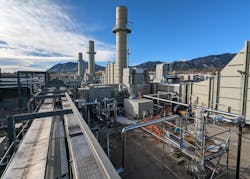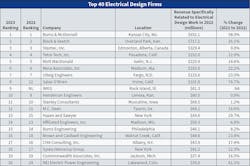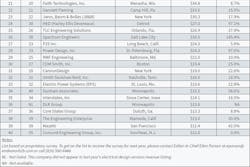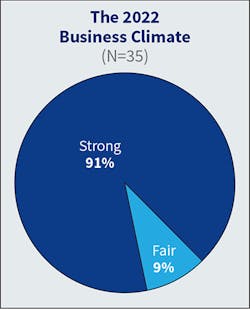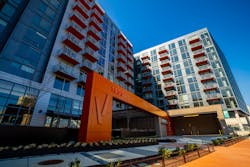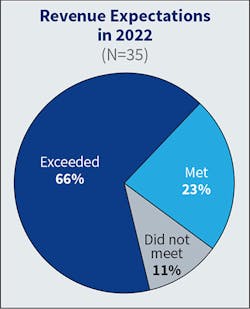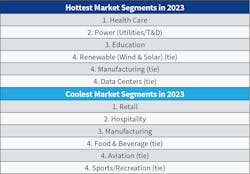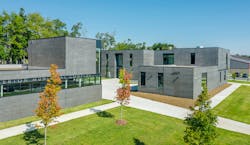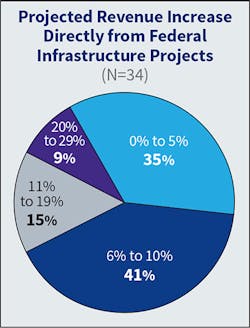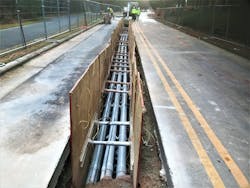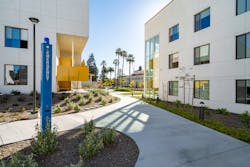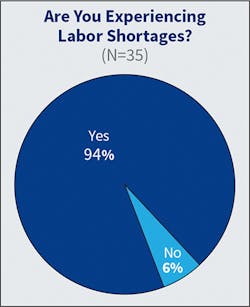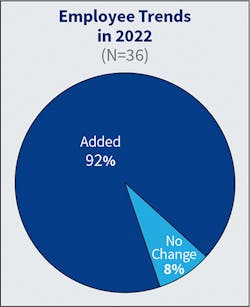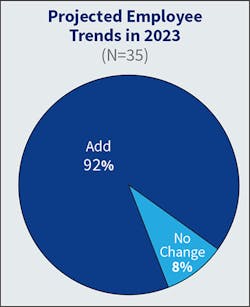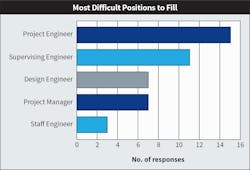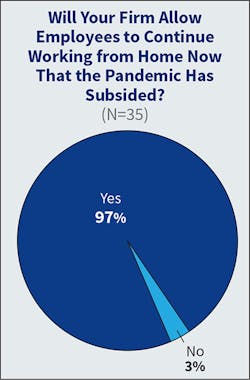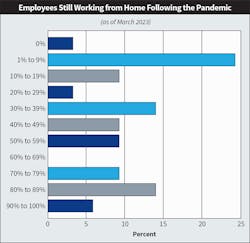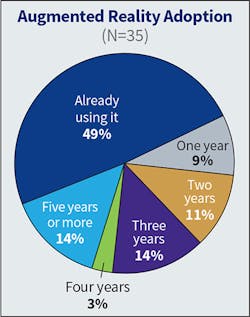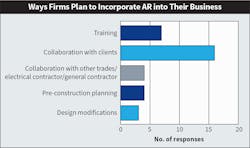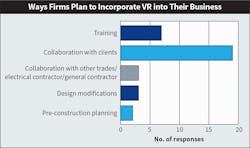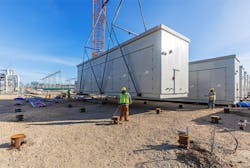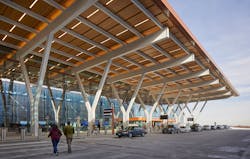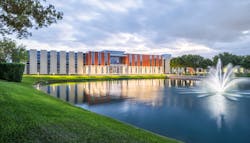A Tidal Wave of Revenue: EC&M's 2023 Top 40 Electrical Design Firms Special Report
The good old days — and then some — returned to the electrical design world in 2022. After two years of subdued activity during the COVID-19 pandemic, electrical design firms appear to have gotten back to business last year, dusting off projects placed on hold and helping action-starved clients make up for lost time. Evidence of that big snapback comes from EC&M’s annual survey of electrical design firms that yields its Top 40 Electrical Design Firms ranked by prior-year revenues (see Rankings Table). This year’s Top 40 had combined reported electrical design revenue of $3.918 billion in 2022. That was 22.2% higher than the combined prior-year revenues of last year’s Top 40, which came in at $3.204 billion (based on 2021 revenue numbers). All firms but one reported higher revenue; the range was an increase of 145% and a decline of 7%. A year earlier, six of the returning Top 40 reported year-over-year decreases.
“It was an amazing year, absolutely,” says Brian Leavitt, principal and director of electrical engineering at IMEG (No. 9), Rock Island, Ill., “one that the design and construction industry was looking for. Regardless of pricing and materials issues, there was a lot of demand, and almost every category was strong for us.”
The overall feel to the year, he says, was one of pushing to get back to normal after the pandemic cloud forced developers to tap the brakes and put growth plans on hold.
“Companies wanted to make up for opportunities lost during COVID, and there was also a surge past that to start pursuing the longer-term goals that they had for these years,” he says.
At Boston-based CDM Smith (No. 30), revenues were up 25%, a result of both stalled work resuming and a bigger share that electrical is gaining in the typical project, says Matt Goss, senior vice president and MEP/energy practice leader.
“Things are definitely getting back to normal coming out of COVID, but there’s also a new focus emerging on projects that are supported by electrical design work — areas such as renewables, microgrids, and EV charging,” he says. “There are more electrical components of jobs and more electrically driven projects, too.”
A welcome surprise
Another sign that last year was good for most design firms is that backlogs surged again — evidence that work was there for the taking, and firms were perhaps eager to lock up and stock up amidst concerns about a possible recession. Like last year, when 86% of firms said backlog grew in the previous year, 83% of this year’s ranked companies said 2022 showed an increase (Fig. 3). That was a welcome development, considering that only half of the 2021 Top 40 reported an increase in 2020. Of those reporting an increase, half said it was modest, in the 6% to 9% range, though a third said it exceeded 15%.
“We achieved 19% organic growth last year, partly a result of growing client relations and more cross-selling new built-environment services into those relationships,” Anderson says, noting the company wins about 80% of the opportunities it seeks. “At the same time, we’re adding to the market sectors we want to grow in by continuing to find more firms to merge and partner with.”
Revenue growth at Smith Seckman Reid, Inc. (No. 32), Nashville, Tenn., fell back from 50% in 2021 to 19% last year, due in part to many projects’ extended duration caused by supply chain issues, says Simon Gandica, electrical discipline resource manager. But both revenue and backlog growth exceeded expectations, making for a solid year.
“A lot of projects that had gone on hold were restarted, but we also benefitted again from ongoing relationship-based business from our loyal clients and trusted partners,” Gandica says.
The firm’s electrical revenues continued to benefit from recent office expansions into high-growth areas of Texas and the Southeast and strong demand in its focus markets of special “complexity,” such as health care, sports, and industrial, says Mario Valentini, electrical discipline resource manager.
To the mild surprise of Vice President Ryan Cross, commercial and industrial projects picked up at Electric Power Systems (No. 33), St. Louis, as owners opened their wallets in a bet on an eventual resurgence. It was also another strong year for renewable energy, a focus sector with solid prospects as opportunities for more EPC/turnkey design-build projects play to the company’s strengths.
“Only a small number of companies have been able to do that, but now there’s a larger pool that we belong to that can,” he says. “I think the future is bright there.”
A big airport project in its backyard, Kansas City International helped Henderson Engineers (No. 10), Lenexa, Kan., keep its electrical revenues in line with 2021 and further immerse the firm in another emerging market opportunity.
“Aviation, fueled by KCI, was a bigger market for us, one we didn’t have much focus on before,” says Jason Wollum, chief sector officer, noting that it could follow the pattern of the firm’s mounting involvement in electrical-heavy data center/mission critical work.
Blue-skies scenario
Continued market sector expansion, more electrical work, the sustainability of the “electrification” trend, and the economy’s ability to skirt a recession are some key wild cards in electrical design firms’ ability to keep the good times going into 2023 and beyond. A repeat of 20% growth might be a stretch, but three-quarters of firms predicting do expect revenues to increase this year (Fig. 4), a lower share than projected increases in 2022. And, in line with last year, about 80% see backlog increasing as well (Fig. 5), with growth topping out shy of 10% for most.
“We’re taking market share in areas like health care, which is new for us in the past five years, and transit, where the electrification trend is taking hold,” he says. “A new national practices leader who was with the Los Angeles metro system is in place now, leading that transit effort. And we’re expanding in New York and LA, where we see initiatives around carbon reduction growing.”
“Some of our markets have good tailwinds, and the need for critical infrastructure that we focus on means lower chance of a downturn even though the economy does seem to be slowing,” he says, which will affect developers more subject to interest rate spikes and softer conditions. “So, I think growth continues for us into 2023.”
Some of the optimism is likely tied to prospects for higher government spending on infrastructure. Long-term investments in the electrical grid, renewable energy, green buildings, transportation, roads and bridges, and other pillars of a 21st-century economy are already starting to factor into design firms’ revenue projections.
With a strong presence in the public spending sphere and special expertise in water, transportation, and energy, CDM Smith is primed to benefit from more infrastructure spending that could expand to incorporate microgrids, EV charging, and renewable energy — and make this year less dicey, Goss says.
As a multi-discipline engineering firm, IMEG’s electrical design teams could ride a wave of infrastructure work, Leavitt says. There are already signs of activity through government agencies — “we’re seeing the tip of it now” — that hold some promise of extended involvement by the firm that will impact electrical, maybe even lifting 2023 revenues alone by 10% to 20%.
“A lot of the civil work that might come out of this will likely feed into MEP,” he says. “We won’t pivot the entire organization toward this work because that will eventually go away, but it can sustain you for a long time.”
Labor issues persist
Over time, infrastructure work could prove to be gravy for many design firms looking to grow. And, of course, what firm isn’t? But obstacles to growth are ever-present and often changing. One that persists, though, is the challenge of maintaining a capable workforce. The difficulty of finding and retaining quality workers was again rated the top growth impediment this year, far outpacing other factors (Fig. 9).
New York-based Syska Hennessy Group (No. 18) is banking on its growing involvement in projects that have significant cutting-edge technology components to act as a lure for engineers who have many employment options, says President and CEO Cyrus Izzo. The firm continues to bring on motivated college graduates every year and aims to keep their fires burning with a dedicated engineer development program — and through a startup-investment initiative that positions the company to deliver direct designer exposure to emerging design technologies.
Newly minted talent can only go so far in supplying firms’ personnel needs, however. Firms engaging in a growing array of projects heavy on electrical emphasize the need for engineers who can build on established skill sets and take leadership roles in groups that are having to stretch their capabilities.
“The big one for us is the experienced engineer,” says Goss, whose top CDM Smith staffing challenge is design engineer. “It seems we can identify and attract new engineers, but it’s not always the solution to go that route. Those experienced people are key — the mid-level types who can bolster the team.”
One way some firms are navigating hiring issues is to make remote, non-office-based work, more available. A trend that started during the depths of the COVID-19 pandemic, work-from-home arrangements have become normalized, giving employers a tool to possibly make life easier for employees without sacrificing work quality. Almost every firm says they’re letting formerly office-based workers work from home full- or part-time post-pandemic (Fig. 14). Just shy of 40% of Top 40 firms say they’re still permitting at least half of employees who switched to remote work during the pandemic to continue to do so (Fig. 15). That number, though, has been falling. Slightly more than half of last year’s Top 40 said that was the case; the year before it was 100%.
Like many other firms, Burns Engineering is adopting a hybrid model that blends remote and on-site work. Three days in the office and two at-home is now the default, Walton says — an arrangement that recognizes the value of both but tilts toward a return to business as usual.
“Remote work has given us more flexibility and options,” he says, “but we see value in having that in-person collaborative and coordination part of the hybrid approach.”
Ultimately, he says, there’s a trade-off. Office-based work, he says, remains critically important for getting younger staff trained and mentored, but the ability to offer technology-enabled remote work probably does expand the hiring and recruitment lens.
Syska Hennessy is taking a less nuanced view. Izzo is adamant that in-office, face-to-face work is preferable (if not essential). Staff have been mostly back in office for a year and a half; now the standard is four 10-hour days in office with a four-hour day Friday that can be remote.
“There’s room for some flexibility, but our clients expect us to be in the office and on job sites, and the construction community we work with requires that field time,” he says. “So, we don’t see how we can be successful being on a Zoom camera or a Teams call.”
Technology to the rescue
One of the many emerging technologies that will be at firms’ disposal is augmented reality (AR) and virtual reality (VR), tools adaptable to either enhancing or fully simulating project designs. Almost half of respondents say their firms are now using both AR and VR in some fashion in their work, a number that has been rising. And with both, collaboration with clients is the undisputed top application (Fig. 16, 17, 18, and 19).
More specifically, about a dozen firms noted how they’re using it in electrical design. Among AR uses are “electrical room space planning”; “electrical design team collaboration”; “in BIM models for clash detection”; “electrical product development and site placement”; and “walk-through models to assist in project development.” With VR, uses noted were: “walk through of facilities with complex electrical and mechanical systems”; “conduit and cable tray layout”; “training operators”; “visualization of designs with clients and trade partners”; “simulation for process automation”; and “mapping powerhouse interiors.”
Second to client collaboration, firms cited training as a way they’re using AR/VR, and the number of mentions doubled. At EPS, Cross says, AR/VR will be a central component of a new training center its parent company is opening in Nashville, Tenn. to aid EPS and sister companies. It will deliver the type of “immersive” training experience employees need to learn elements of design and construction and to work safely, he says.
Training for the future
Training, more broadly, remains a top focus of Top 40 firms. Given persistent hiring challenges, more complex design demands, and a fast-changing and an evolving electrical design world, the ability to effectively deliver pertinent and essential training is paramount. Training areas of top concern for firms may reflect some of the market pressures they’re feeling. The top areas firms say employees need the most training support in, firmly headed by power systems analysis, align with trending issues design firms encounter (Fig. 20).
Wollum says electrical safety and aspects of smart buildings are key areas of training needed at Henderson Engineers. Designers must be familiar with incident energy calculations and updates to the National Electrical Code that reflect rapid changes in how power is generated and distributed. With buildings, clients need electrical designers who fully grasp the complexities of management and automation systems that consistently overpromise and underperform.
“That’s a lost discipline,” he says. “But it’s a critical piece of making buildings function that is not well defined and that clients are routinely frustrated with. So, we’re working to create that as its own discipline here.”
With demand for smart, energy-efficient, and fully electric buildings growing, Henderson may be aiming for a niche — something many Top 40 firms in a crowded and demanding marketplace appear to covet. Looking down the road, most firms picked gaining a competitive advantage, specifically via technology, from a short list of possible top long-term company concerns (Fig. 21). Further down in mentions were factors related to personnel management magnified during the pandemic.
Both are related, Wollum says, in that AR/VR, BIM and similar tools improve productivity and help firms navigate likely challenges in finding sufficient design talent.
“Technologies like generative design and artificial intelligence, maybe more than AR/VR, are going to push electrical engineering forward,” he says. “Demand for design professionals is growing, but fewer may be available — so technology can help bridge that gap.”
Along with long-term strategic concerns, design firms dealt with a full plate of short-term tactical issues that took root in 2022 and continue into 2023. Supply chain snarls and delayed and cancelled projects were the top vote-getters from a list of factors possibly exacting short-term pain on design firms last year (Fig. 22).
Equipment delays, materials shortages, and project delays presented significant design challenges last year at Burns Engineering, and there’s no indication they’re in the rear-view mirror, Walton says.
“Supply chain issues are continuing. For major equipment like switchgear and transformers, lead times have gone from 16 to 24 weeks to a year,” he says. “We’ve had to design around this and communicate more closely with clients about delays, lead times, and the cost impact of inflation on major components of projects.”
For electrical design firms, 2022 will likely go down as a year that produced mixed emotions; revenue growth was off the charts, but the work was frantic and full of novel challenges. That may be a sign of things to come. The future looks bright, but speed bumps from economic uncertainty and disruption could emerge in the short-term, and growing demand for services over the longer term will pressure firms to supply the resources equal to the challenge.
“The market is very robust, but the industry is short on electrical designers while the needs will continue to accelerate,” says Salas O’Brien’s Anderson. “My goal is to marshal as much great electrical engineering talent as possible.”
Tom Zind is an independent analyst and freelance writer based in Lees Summit, Mo. He can be reached at [email protected].
About the Author
Tom Zind
Freelance Writer
Zind is a freelance writer based in Lee’s Summit, Mo. He can be reached at [email protected].
